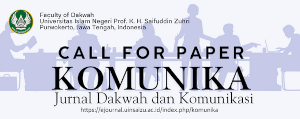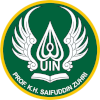PARADIGMA KEILMUAN KPI DALAM PERSPEKTIF DAKWAH
DOI:
https://doi.org/10.24090/komunika.v10i2.951Keywords:
KPI, Da’wah, Scientific designAbstract
Islamic Communication and Broadcasting or commonly known as KPI, as one of the majors in Islamic colleges, must have an identity. Basically, the KPI’s scientific design can not be separated from two things, first, at the scientific level, the device is able to make science communication and science propaganda as the basis of activity design and the movement of Islamic broadcasting through various paradigmatic, theoretical, and methodological approaches. This is what is referred to as the ability of theoretical understanding (knowledge-based capability). Second, at a practical level, facilitating the growth of capabilities that could be the foundation undergraduate professional competence of KPI. Komunikasi dan penyiaran Islam atau yang biasa dikenal dengan KPI, sebagai salah satu jurusan di perguruan tinggi agama Islam, harus mempunyai identitas. Pada dasarnya desain keilmuan KPI tidak terlepas dari dua hal, Pertama, di level keilmuan, mampu menjadikan perangkat ilmu komunikasi dan ilmu dakwah sebagai basis dari desain aktivitas dan gerakan penyiaran Islam melalui berbagai pendekatan paradigmatik, teoritik, dan metodologis. Inilah yang disebut sebagai kemampuan pemahaman teoretik (knowladgebased capability). Kedua, di level praktis, memfasilitasi tumbuh kembangnya kemampuan yang dapat menjadi pijakan kompetensi profesi sarjana KPI.Downloads
Download data is not yet available.
References
Adnani, Kamila. (2012). “Reorientasi Kurikulum Program Studi Komunikasi Dan Penyiaran Islam (KPI) Fakultas Ushuluddin Dan Dakwah IAIN Surakarta.†Jurnal Kodifikasia 6, No. 1.
Heryanto, Hermin Indah Wahyuni dan Gun Gun. (2013). “Komunikasi dan Penyiaran Islam Masa Depan: (Epistemologi KPI dan Penguatan Eksistensi Jurusan KPI).†Seminar Nasional dan Forum Komunikasi Penyiaran Islam se Indonesia di Yogyakarta 1: 35–54.
Litte John dan Foss. (2011). Teori Komunikasi. Jakarta: Salemba Humanika. Tim Penyusun. (2014). Panduan Akademik STAIN Purwokerto 2014-2015. Purwokerto, STAIN Press.
Sumai, Sumarni. (2010). “Arah dan Tujuan Program Studi Komunikasi Penyiaran Islam (KPI) Jurusan Dakwah†3, no. 5: 50–58.
West, Richard & Lynn H. Turner. (2010). Introducing Communication Theory: Analysis and Application. Boston: McGraw-Hill.
Zamroni, Mohammad. (2015). “Epistemologi dan Rumpun Keilmuan Komunikasi Penyiaran Islam.†Jurnal Informasi 45, no. 1.
Heryanto, Hermin Indah Wahyuni dan Gun Gun. (2013). “Komunikasi dan Penyiaran Islam Masa Depan: (Epistemologi KPI dan Penguatan Eksistensi Jurusan KPI).†Seminar Nasional dan Forum Komunikasi Penyiaran Islam se Indonesia di Yogyakarta 1: 35–54.
Litte John dan Foss. (2011). Teori Komunikasi. Jakarta: Salemba Humanika. Tim Penyusun. (2014). Panduan Akademik STAIN Purwokerto 2014-2015. Purwokerto, STAIN Press.
Sumai, Sumarni. (2010). “Arah dan Tujuan Program Studi Komunikasi Penyiaran Islam (KPI) Jurusan Dakwah†3, no. 5: 50–58.
West, Richard & Lynn H. Turner. (2010). Introducing Communication Theory: Analysis and Application. Boston: McGraw-Hill.
Zamroni, Mohammad. (2015). “Epistemologi dan Rumpun Keilmuan Komunikasi Penyiaran Islam.†Jurnal Informasi 45, no. 1.
Downloads
Issue
Section
Articles
License
Authors who publish with this journal agree to the following terms:
- Authors retain copyright and grant the journal right of first publication with the work simultaneously licensed under a Creative Commons Attribution-ShareAlike 4.0 International License that allows others to share the work with an acknowledgement of the work's authorship and initial publication in this journal.
- Authors are able to enter into separate, additional contractual arrangements for the non-exclusive distribution of the journal's published version of the work (e.g., post it to an institutional repository or publish it in a book), with an acknowledgement of its initial publication in this journal.
- Authors are permitted and encouraged to post their work online (e.g., in institutional repositories or on their website) prior to and during the submission process, as it can lead to productive exchanges, as well as earlier and greater citation of published work (See The Effect of Open Access).

























